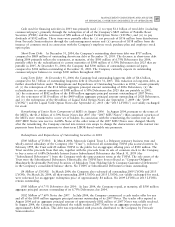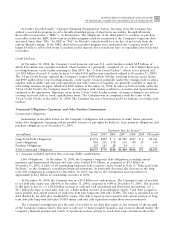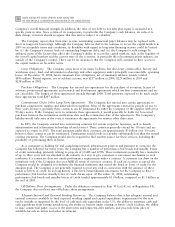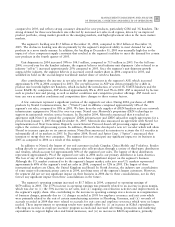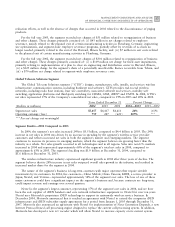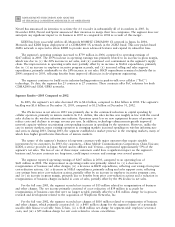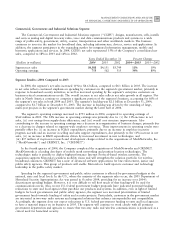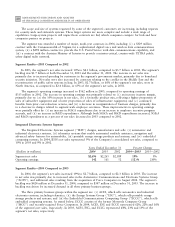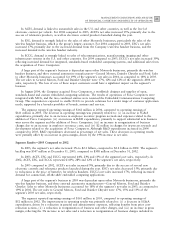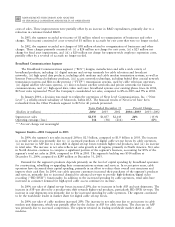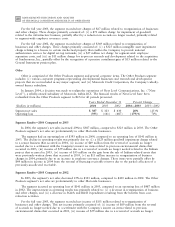Motorola 2004 Annual Report Download - page 66
Download and view the complete annual report
Please find page 66 of the 2004 Motorola annual report below. You can navigate through the pages in the report by either clicking on the pages listed below, or by using the keyword search tool below to find specific information within the annual report.
58 MANAGEMENT'S DISCUSSION AND ANALYSIS
OF FINANCIAL CONDITION AND RESULTS OF OPERATIONS
Nextel has announced its intention to activate the 6:1 vocoder in substantially all of its markets in 2005. In
December 2004, Nextel and Sprint announced their intention to merge their two companies. The segment does not
anticipate any signiÑcant impact to its business in 2005 as compared to 2004 as a result of this merger.
KDDI has been successful with its all-Motorola 800MHZ CDMA2000 1X network in Japan. In 2004,
Motorola and KDDI began deployment of a CDMA2000 1X network in the 2GHZ band. This new packet-based
2GHz network is expected to allow KDDI to provide more advanced features and expand its subscriber base.
The segment's operating earnings increased to $759 million in 2004, compared to operating earnings of
$247 million in 2003. The 207% increase in operating earnings was primarily related to an increase in gross margin,
which was due to: (i) the 24% increase in net sales, and (ii) continued cost containment in the segment's supply
chain. The improvements in operating results were partially oÅset by an increase in SG&A expenditures, primarily
due to: (i) an increase in employee incentive program accruals, and (ii) increased selling and sales support
expenditures, primarily attributable to the 24% increase in net sales. R&D expenditures remained relatively Öat in
2004 compared to 2003, reÖecting beneÑts from improved eÇciencies in development engineering.
The segment continues to build on its industry-leading position in push-to-talk over cellular (""PoC'')
technology. To date, the segment has 23 contracts in 27 countries. These contracts oÅer PoC solutions for both
CDMA2000 and GSM/GPRS networks.
Segment ResultsÌ2003 Compared to 2002
In 2003, the segment's net sales decreased 4% to $4.4 billion, compared to $4.6 billion in 2002. The segment's
backlog was $1.6 billion at December 31, 2003, compared to $1.2 billion at December 31, 2002.
The 4% decrease in net sales in 2003 was primarily due to the continued reduction in capital spending by
cellular operators, primarily in mature markets. In U.S. dollars, this sales decline was roughly in line with the overall
sales decline in the wireless infrastructure industry. Operators spent less on new equipment because of pressure to
reduce costs and declines in average revenue per user. In addition, technology enhancements greatly improved
network capacity without necessitating corresponding increases in spending by the operators. However, unlike the
case in mature markets, many existing operators in emerging markets increased spending on wireless infrastructure
and services during 2003. During 2003, the segment established a market presence in the emerging markets, many of
which have higher growth rates than those of mature markets.
The nature of the segment's business is long-term contracts with major operators that require sizeable
investments by its customers. In 2003, Ñve customersÌChina Mobile Communications Corporation; China Unicom;
KDDI, a service provider in Japan; Nextel and its aÇliates and VerizonÌrepresented approximately 55% of the
segment's net sales. The loss of one of these major customers could have a signiÑcant impact on the segment's
business and, because contracts are long-term, could impact revenue and earnings over several quarters.
The segment reported operating earnings of $247 million in 2003, compared to an operating loss of
$621 million in 2002. The improvement in operating results was primarily related to: (i) a decrease in
reorganization of business and other charges, (ii) a decrease in R&D expenditures, reÖecting cost savings from prior
cost-reduction actions, (iii) a decrease in SG&A expenditures, primarily selling and sales support costs, reÖecting
cost savings from prior cost-reduction actions, partially oÅset by an increase in employee incentive program costs,
and (iv) an increase in gross margin, primarily due to beneÑts from prior cost-reduction actions and a reduction in
reorganization of business charges included in costs of sales, partially oÅset by the 4% decline in net sales.
For the full year 2003, the segment recorded net income of $13 million related to reorganization of business
and other charges. The net income primarily consisted of a net reduction of $39 million in accruals for
reorganization of business costs that were no longer needed, partially oÅset by a $32 million charge for in-process
research and development related to the acquisition of Winphoria Networks, Inc.
For the full year 2002, the segment recorded net charges of $610 million related to reorganization of business
and other charges, which primarily consisted of: (i) a $401 million charge for the segment's share of a potentially
uncollectible Ñnance receivable from Telsim, (ii) a $128 million net charge for segment-wide employee severance
costs, and (iii) a $55 million charge for exit costs related to a lease cancellation.



